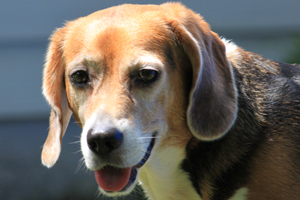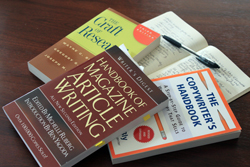
I love dogs. Whether they’re yappy ankle-biters or floppy-eared, soulful-eyed, behemoths, they’ve got a place in my heart.
But a special place is reserved for my favorite breed, the Beagle, and I’ve been lucky enough to have been adopted by a few in my lifetime. And just like my two-legged companions, my four-legged furry friends have had a wide range of personality types.
For example, my second beagle, Tiger, was Westminster Show Dog good and loyal beyond a fault. My mom got many a phone call from the school because Tiger escaped from the yard and pulled a B & E on my first grade classroom so he could spend the day with me.
Then there was Mystic, whose approach to life was “I wouldn’t behave if you rolled a squirrel in bacon and presented it to me in a silver dog-dish.” She was a laugh a minute and sweet as could be, but she could also chew through a crate that the “experts” claimed was chew-proof.
Now there’s Ares, my current furry companion. He lies somewhere smack in the middle of that spectrum. He’ll behave for about five seconds if I bribe him with bacon (minus the squirrel, thank goodness) but if his mind or nose gets set on something, nothing short of the Kraft factory’s stock of cheese will change his course.
However, some of his more “unbehaved” traits have given me a few interesting insights on being a writer.
Race, Sniff, and Leg Lift
Say the word “walk” and Ares howls and runs for the door. He’ll even plant his furry butt on the mat and impatiently wait for you to clip on the leash. Whatever you do though, make sure you brace yourself before opening that front door. The sitting all cute with his tail wagging thing is just for show. The moment that door is opened, he’s through it like the Black Friday crowd at Walmart.
That same tree he peed on yesterday is a brand new tree to race to, sniff and pee on again today. Same goes with the patch of grass next to the tree, the gutter next to the mailbox and the mailbox itself. Then, finally, we make it out of the yard. For the first few minutes it’s “race here and smell!” then “race there and sniff!” There’s so much to explore and he’s got to sniff it all.
After a few minutes of racing, sniffing and leg-lifting, he’s either worn himself out or notices that he’s dragging me face first down the sidewalk and slows down to a sedate walk. At this point, he becomes a little more choosy about where he sticks his nose.
But I’ve learned something from the daily bi-polar dog walk.
When I first sit down for that day’s writing session, I need let my fingers fly and mind race from the gate. Don’t worry about mistakes or if what I’m writing sounds stupid. Revisit the same mental ground I saw yesterday if I want to. It may smell better today. And if it does, I should just let my mind lift its leg and mark that spot.
Afterwards though, it’s time to reign in my brain and put on my critical thinking cap. At this point, I need to be choosy about what from those mental explorations to keep.
The time to suck on purpose is over.
Let Thy Nose Guide Thee
Ares can smell a slice of cheese from a backyard away. And he’ll try to find it.
As a matter of fact, that dog lives by his nose. Our walks are usually wild trails through the neighborhood. One second, we’re on the sidewalk and the next he’s caught the scent of something and I’m on my hands and knees trying to drag him out from under a bush (thank goodness for awesome, dog-loving neighbors and no skunk encounters). If he’s curious about a smell, he’s off to investigate.
I’ve learned to do the same, in a manner of speaking. I’m no longer so worried about the “write what you know” rule. I let my curiosity be my guide and if something strikes my fancy, I learn about it so I can write about it.
Also, if my mind starts to wander as I write, I let it. I’ve found that my brain can lead me down some very interesting pathways; places I may not have gone had I been consciously thinking about it. There are definitely times when I have to back-track and run from a mind-skunk. But that’s part of the fun.
Don’t Forget My Treat – I’ll Take Bacon
Once we’ve finished our walk, we’re back and both chugging water. Ares is also usually staring me down, ready for his post-exploration treat. Hey, after that many leg lifts, I might be a little hungry too.
So out comes his all-natural, bacon flavored cookie. (Don’t tell him his treats are actually good for him. He’ll go all ninja on the fridge while I’m asleep if you do.) Hard work deserves a reward.
Same with writing. If I make my goal for the day or week, I give myself a pat on the back and a little treat. Whether it’s cracking open a new book, taking a dog-free walk to enjoy the sunshine, or 30 minutes of smiting the Horde, I try to make sure I reward myself for putting my backside in the chair and getting my work done. Positive reinforcement does wonders for my enthusiasm and work product.
What has your pet (if you have one) taught you about your work or life’s passion? And do you know of a good “beagle training book…”
Photo Credit: Karen Bristow

